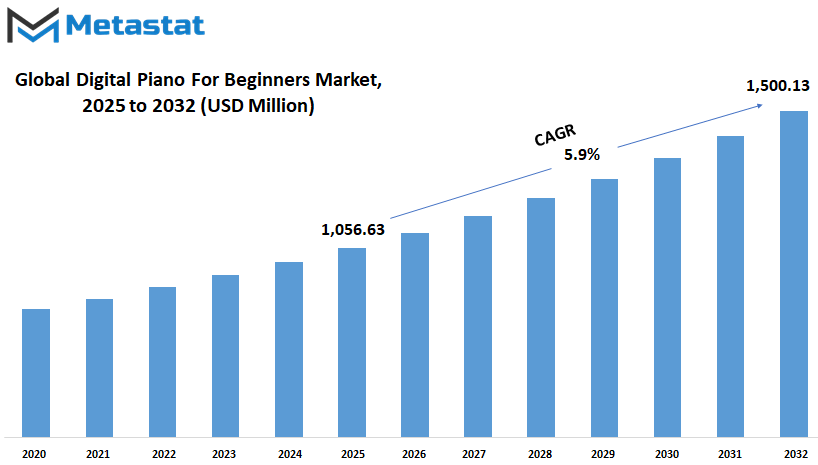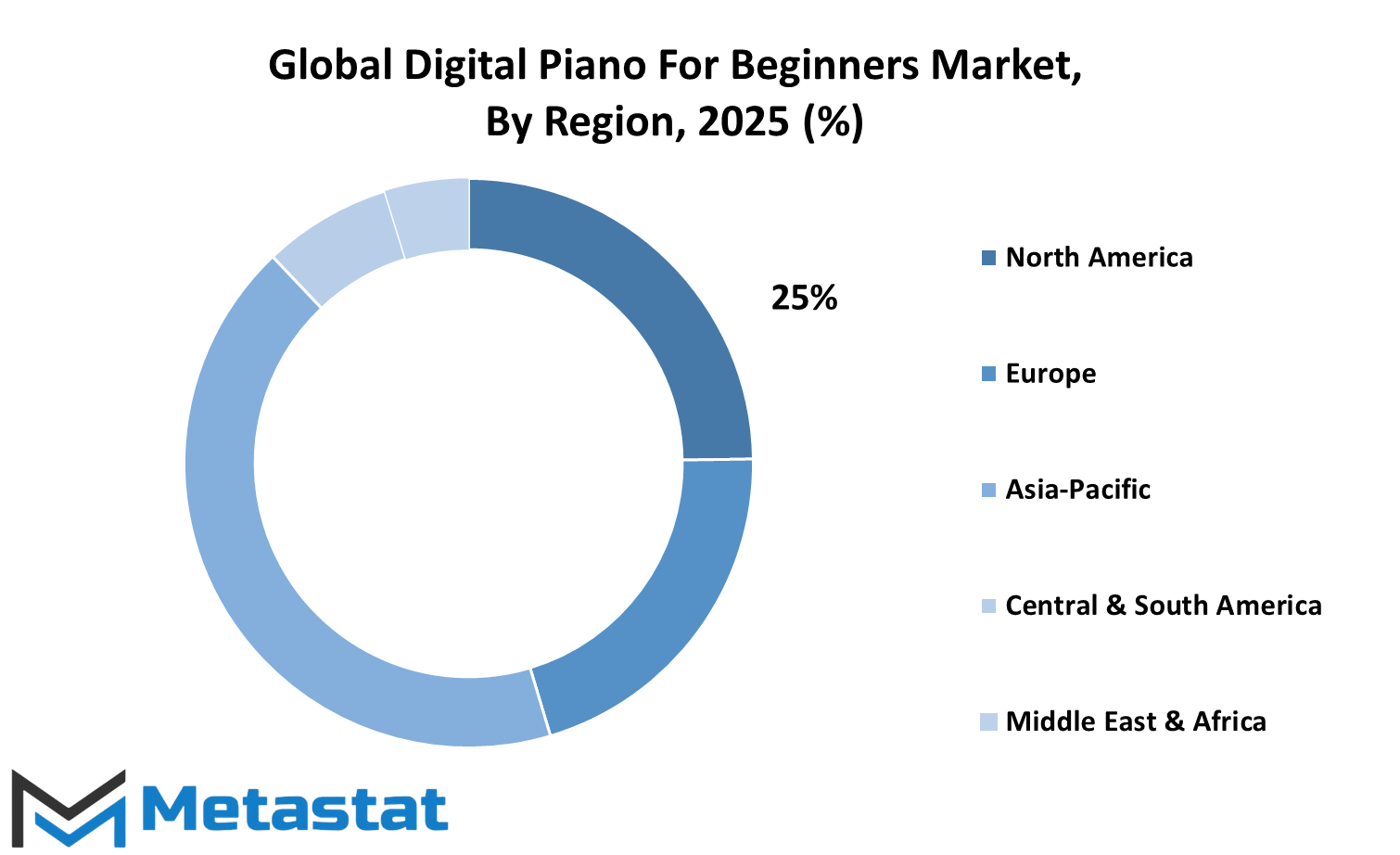MARKET OVERVIEW
The Global Digital Piano for Beginners Market in consumer electronics and musical instruments will determine how entry-level musicians earn their living and eventually seek learning around the piano. The market is for digital pianos targeted specifically at people who currently have a budding interest in music. These pianos combine simplicity with affordability and, more importantly, technology-driven features oriented toward novice users. Unlike the adult digital instruments, these entry-level digital pianos are characterized in its user interfaces, guided learning aids, and lightweight, portable designs that enable them to be used readily at home or in educational environments.
This Global Digital Piano for Beginners market continues to be concerned about the digital aspects of music in education. The manufacturers would thus continue to make instruments in such a way that they resemble traditional acoustic pianos in sound and touch but provide up-to-date options such as Bluetooth connectivity, built-in learning software, and interactive touch displays. Such offerings allow learners to use the system both in self-teaching and formal learning, giving them tools suited to their pacing. The brands will also compete as to how well they will fine-tune sound engines and keyboard action so that beginners experience a responsive and intimate playing environment without being overwhelmed by many technicalities.
The Global Digital Piano for Beginners market will structure itself to accommodate all the varied needs of users, from the casual learner to the young student enrolled in a formal music course. Besides schools and academies, online platforms will also significantly fuel demand for beginner digital pianos, which will soon become standard tools for teaching introductory music. Portability and space efficiency will still be important, especially for users living in urban apartments or in dormitory settings. Energy and durability will also be important for manufacturers, who will ensure that the instruments withstand regular use without affecting sound quality and tactile feedback.
In the wider context of the music technology landscape, the Global Digital Piano for Beginners market will establish uniqueness in its offering-simple solutions, without compromising on some essential features. The market will stretch from very high prices to very low ones, allowing diverse consumers to pick instruments based on their budget and preferred usage or learning method. That will suit both global players and regional brands in their disjoint marketing efforts, as they will be able to provide tailored solutions for specific segments, such as children, teenagers, adults returning to music, or complete novices.
Digital platforms and online marketplaces will govern where and how products of the Global Digital Piano for Beginners market will be sold. By having online reviews, tutorials, and demo videos as bigger influences on their purchase decisions, brands are used to aligning products with digital content strategies aimed at developing initial trust from beginner consumers. Partnerships with educational app developers and content creators will also add visibility and perceived value for beginner digital pianos, thus creating an ecosystem that will motivate continuation and progression.
The Global Digital Piano for Beginners market will further increase scope-wise at the juncture of technology, availability, and educational utility. Emerging musical education in the digital context has led to the possibility among pupils of tapping into fun yet practical entry points into an incredibly rich musical experience of piano playing. This market promises functionality and inspiration solutions for laying the groundwork for music in accessible, contemporary formats.
Global Digital Piano for Beginners market is estimated to reach $1,500.13 Million by 2032; growing at a CAGR of 5.9% from 2025 to 2032.

GROWTH FACTORS
The Global Digital Piano for Beginners market is seeing gradual acceptance of a URL in the light of interest shown by many in learning music. With more emphasis on personal accomplishment and creative hobbies, many are turning towards music, and digital pianos have turned out to be a choice number one among all beginners. Their simple functional features of operation, easy availability, and convenient portability are offering a practical alternative to conventional pianos. With this growing fervor for learning music acts as a fuel in pushing the market forward, and it seems likely to be continuing with the discovery of joy and value of playing an instrument.
As technology keeps improving, this has become one of the key factors driving the growth of this market. After all, over the years, digital pianos have gotten better and better in very realistically imitating the sound and feel of acoustic. Rapid development includes both improved sound samples and whole key-touch simulation with integrated learning features of the instrument itself. Thus, more encouragement has spurred potential newcomers joining in the fun. Times change, and instruments go lower in price, allowing the new players to build confidence and skill level. In the coming years, new technologies will come to market that will feature even more advanced technologies, making these digital pianos even smarter and more helpful to be used by non-musicians.
Still, there are challenges. Chief among them is one of the barriers to entry for many new learners: cost. And while some are budget items, the best types still remain a little pricey for some pockets. Be this the case, then, others may want to grapple with learning but might justifiably shy away from investing in the quality digital piano. The second problem is getting used to it. One with time put into the acoustic piano will find it hard adjusting their touch to a digital one since it sounds and feels differently. Such are challenges that may hinder and slow the promotion unless solutions come in handy to facilitate learning to become one of the more relaxing and cheaper options.
Well, these hurdles also create scope for the future. One of the most promising areas is interaction between digital pianos and online learning applications. With more and more platforms around offering lessons with interactive features, beginners can easily have a helping hand without stepping out of their doors. This is making learning more flexible and fun whereas is a window for more people to take up music. Thus the Global Digital Piano for Beginners market expects a steady growth in future with the evolution of digital pianos themselves being assistive in smart learning.
MARKET SEGMENTATION
By Type
The Global Digital Piano for Beginners market is slated for a vibrant reshaping in the coming years owing to technology, lifestyle changes, and the global growth of music as a hobby and a learning tool at different levels. The attention of these beginner piano instruments in now likely to attract even greater attention as they become even further user-friendly and more applicable in practice since they enable an individual's entry point into their musical development.
Among the major concerns that one can tell from how the Global Digital Piano for Beginners market will evolve regarding the future is the kind of designs that manufacturers will adapt to user experience and requirement. Smarter learning instruments are learned to be much more common, as should be the case for digital pianos. These features would normally include interactivity less accompanied by touch sensitivity or Bluetooth connectivity, which are already critical fittings that make learners more confident. These features not only facilitate the process of practice but also contribute to a more exciting and enriching learning environment.
As per type view, the market embraces Vertical Digital Piano, Grand Digital Piano, and Portable Digital Piano. Each of them has its distinct use in life. Vertical Digital Pianos are normally used in homes which need to have them but at the same time concentrate on sound. Grand Digital Pianos have a broad visual appeal but are meant for those who wish to have a traditional look in convenience with a digital facility. Portable Digital Pianos receive a picture of easy travel and storage, thus appealing to those learners who go out of homes very frequently. Such options will continue exciting different lifestyles and levels of skills, furthering consumer's choice.
The Global Digital Piano for Beginners market is expected to continue growing steadily over time with people getting more involved with self-learning and homely hobbies. Besides, the schools or music instructors who have gone to these online or blended-class formats would further hike the incidences of demand towards digital pianos. This means much more advanced features for student instruments, establishing new meanings of entry-level instrumentation. As a result, entry-level instruments may lose their immense gaps from professional models and allow exposing new learners at earliest stages to very high sound quality and features.
Wise innovations according to consumer needs and an uphill thrust in the importance of music in human life will determine the future course of the Global Digital Piano for Beginners market. As the need for psychosocial outlets in creativity becomes more compelling, so will the continued relevance of digital pianos in that experience for beginners.
By Application
When it comes to the Global Digital Piano for Beginners market, there will be drastic changes as the technology develops and consumer needs evolve. This market caters to individuals who want to start their musical life through digital pianos that are easy and enjoyable to learn on. Owing to more and more people taking an interest in music, there shall be a gradual rise in the demand for digital pianos customized and tailored to the needs of beginners; therefore, it is interactive in itself.
The performance is one main use for these digital pianos. Now, while beginners may not be active on stage initially, many do aspire to honing their skills for performance applications. Digital pianos manufactured for that effect often have design features that replicate the feel and sound of stationary acoustic pianos and also have extra tools to assist the player in obtaining their skill set. Advances in these kinds of instruments are likely to include computer simulations of realistic key action, improved sound libraries, and customizable settings for nagging a user's technique. The future will hold the possibility of artificial intelligence actually built into the instrument for evaluating player performance and giving recommendations.
Another fairly important space is learning and teaching. Digital pianos have found more and more use in classrooms, in music schools, and in private practice lessons because they lend themselves nicely to structured learning environments. These instruments have provisions for interactive tutorials, connectivity to learning apps, and guided practice modes. As technology continues its advances, digital pianos will also nurture more exotic learning experiences, perhaps even combining augmented reality so that virtual instructors can deliver real-time feedback. Such types of applications will surely provide extra motivation for learning an instrument-and even will make it possible for people to do so without access to the traditional music lesson structure.
For many, the digital pianos are a source of entertainment. Playing music, as we know, is not just about learning an instrument but is rather a way of relaxation and fun. The digital pianos designed with such intent will be able to have built-in rhythms, sound effects, and interactivity that will let them explore different styles of music. The future for such tools may see deeper integration with music streaming services to let users play along with their favorite songs or compose original music using the offered digital tools.
Digital pianos, in addition to the above-mentioned applications, serve others: those concerning music therapy, home decor, or personal relaxation. Many find casual playing music therapeutic via this digital medium for music composition. Future developments may focus more on customization to allow a player to alter sounds and sensation of their instrument to best fit their preferences. Digital pianos may embrace smart home technology and interact with voice assistants and other smart home-connected devices, creating a seamless interactive experience for the players.
By Distribution Channel
The Global Digital Piano for Beginners market is booming. There are new interests in learning instruments, which make digital pianos very popular among beginners because they are very affordable, convenient, and modernized electronics. Unlike the conventional pianos that students have grown attached to learning with, digital ones allow volume control, headphone connections, and many sound options to make learning more interesting. While learning apps and interactive tutorials are now available to beginnnrs at their fullest advantage, never before has there been more help for learners to develop skills.
Another one of the crucial aspects influencing this market is the method in which digital pianos are sold. The distribution comprises largely online and offline modes of retailing. Online retail has transformed the shopping paradigm where buyers find it more convenient to browse and buy from home rather than to go to the brick-and-mortar stores. Nowadays, buyers might compare models, read reviews, and get informed about the products' specifications or pricing, without being physically present in a store. Additionally, most of the services offered online came with discounts and installment schemes, sometimes with bundled accessories, attracting many customers to choose this option.
On the other hand, offline retail is still significant, while online sales are proliferating. Most beginners would like to go to the respective stores to 'play' with different models before making a purchase. Testing the keys, hearing the sound quality, and being advised by sales experts really helps boost confidence in their choice. Music retailers and electronic outlets that display digital pianos give customers the experience that online platforms cannot totally replicate.
The future market is going to further advance. Technology will continue to bring about newer models to make digital pianos even more user-friendly and loaded with features. Future models may even have artificial intelligence integrated into them for real-time feedback regarding a learner's progress. The wireless connectivity will get upgraded, allowing seamless integration with learning apps and smart learning devices.
Perhaps this will also change the balance between online and offline sales. With enhanced tools for virtual demonstrations, online just might expand, while offline stores could utilize new methods of driving clientele, such as personalized tutorials or exclusive in-store experiences. Companies thus gain that competitive edge by investing in both channels-most importantly, guaranteeing beginners have multiple access points to get the right instrument for their learning journey.
The more people that take up music as a hobby or as a skill, the more the demand will increase for beginner-oriented digital pianos. Whether bought from a second-hand shop or directly online, these instruments will continue to be a means by which novices will enter into new realms of experimentation concerning what they might achieve with music effectively reshaping the way music education will be delivered around the world.
|
Forecast Period |
2025-2032 |
|
Market Size in 2025 |
$1,056.63 million |
|
Market Size by 2032 |
$1,500.13 Million |
|
Growth Rate from 2025 to 2032 |
5.9% |
|
Base Year |
2024 |
|
Regions Covered |
North America, Europe, Asia-Pacific, South America, Middle East & Africa |
REGIONAL ANALYSIS
The market for digital pianos geared toward beginners is growing as more people find an interest in learning music. This rapid development of technology allows these instruments to become even more sophisticated and appealing for a novice learner. Digital pianos are widely accepted because they are affordable and packed with features that assist beginners in the learning process. This, therefore, contributes to the high demand for digital pianos across various parts of the world.
The different geographical regions in this market are North America, Europe, Asia-Pacific, South America, and the Middle East & Africa. Each of these regions is influenced by some regional dynamic factors for deciding the growth of digital pianos for beginners. A strong presence of music education programs builds North America, where consumers are more willing to invest in learning tools. The demand from some countries, which include the U.S., Canada, and Mexico, is projected to grow due to an increase in online learning platforms and music schools that incorporate the digital piano in their pedagogy.
The demand in Europe is affected by the long-standing culture of classical music and support of arts education. The UK, Germany, France, and Italy continue to enjoy stable demand as schools and individual learners switch from traditional pianos to digital ones. The ability to practice with headphones and learn guided lessons via built-in software means that these instruments are especially attractive in urban centers where space limitations can be a serious issue.
Asia-Pacific is seeing increased demand in countries such as China, Japan, India, and South Korea. This trend is fuelled by rising disposable income and escalating awareness concerning music education along with government programs to foster art. An equally growing market for digital pianos for beginners is the existing strong manufacturing base catering to produce affordable models. As the digital technology grows stronger, interactive learning features are getting sophisticated in order to encourage new learners to buy such instruments.
In South America, nations such as Brazil and Argentina are looking at steady growth, fostered by a developing taste for music and greater availability of digital pianos on online platforms. The macroeconomic conditions of the region and import regulations may temper sales trends, though accessibility continues to improve as brands expand into this region.
Development opportunities are also rife in the Middle East and Africa. Demands are on a rise in GCC countries, Egypt, and South Africa owing to an increasing proclivity towards Western music and the impact of digital learning modes. Digital piano adoption continues to gain momentum in different parts of the world as more people search for newer ways to develop their musical skills.

COMPETITIVE PLAYERS
The Global Digital Piano for Beginners market is set to become quite a competitive sphere, with each player striving to win the attention of new novice learners throughout the globe. As interest in music increases, particularly among younger generations and hobbyists, digital pianos are favored options because of their user-friendly nature, low price, and blending of technology with music. Many aspiring players are on the lookout for instruments that are easy to handle, lightweight, and connect well with mobile apps or other devices. Because of this demand, brands are in a race to scale up the production of models that not only sound great but also offer the kinds of valuable features capable of guiding a beginner through a musical learning journey.
Well-established names such as Yamaha and CASE are heavily engaged in thwarting each other's plans. They have long been in the market, and their exposure has provided them with an edge in designing instruments that provide a happy medium of quality and user-friendly nature. Other major players like KORG, Roland, and KAWAI also keep looking for new innovative products with touch-sensitive keys, realistic sounds, and in-built learning tools. These companies not only sell instruments but build an ecosystem designed to keep the beginners' motivations high and engaged throughout.
Nord Keyboards, Blüthner, and The ONE Music Group are examples of smaller or more boutique manufacturers who contribute their own forte. While some focus on top-shelf quality and craftsmanship, others devote their energies to smart features and interactive tools. For example, some are designing models that connect directly to mobile devices, allowing easy following of lessons or recording practice sessions. This evermore points to a scenario where learning becomes personalized and adaptive, with digital pianos adjusting to the pace and preferences of the individual user.
The newer ones also like Artesia pianos, Williams Pianos, and Medeli are calling for space in this fast-forwarding market. Their approach often combines competitive pricing and bundled features that make digital pianos attractive to first-time buyers. From now on, greater collaboration between tech developers and instrument makers should be expected. As technology evolves, beginner digital pianos will likely evolve into more interactive, flexible, and user-friendly instruments. This new turn would enable everyone to enjoy the learning experience minus the pressure. The contested nature of these companies will grant better products for learners everywhere.
Digital Piano for Beginners Market Key Segments:
By Type
- Vertical Digital Piano
- Grand Digital Piano
- Portable Digital Piano
By Application
- Performance
- Learning and Teaching
- Entertainment
- Others
By Distribution Channel
- Online Retail
- Offline Retail
Key Global Digital Piano For Beginners Industry Players
- Yamaha
- CASIO
- Guangzhou Pearl River Piano Group
- Samick
- KORG
- KAWAI
- Roland
- Ringway Tech
- Nord Keyboards
- Blüthner
- Piedmont Piano Company
- Alesis
- Kurzweil
- Medeli
- Suzuki Musical Instruments
- Artesia pianos
- Williams Pianos
- The ONE Music Groupy
WHAT REPORT PROVIDES
- Full in-depth analysis of the parent Industry
- Important changes in market and its dynamics
- Segmentation details of the market
- Former, on-going, and projected market analysis in terms of volume and value
- Assessment of niche industry developments
- Market share analysis
- Key strategies of major players
- Emerging segments and regional growth potential








 US: +1 3023308252
US: +1 3023308252






